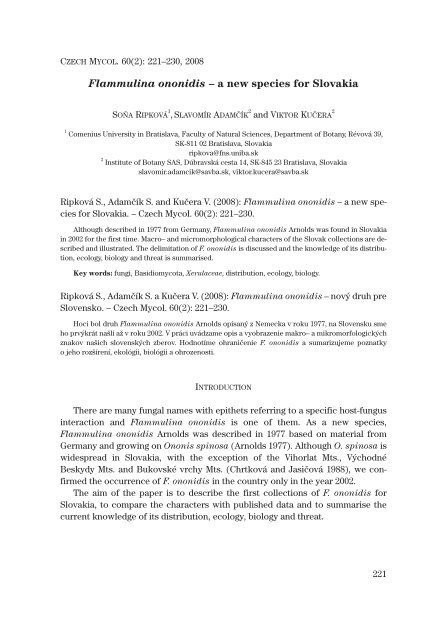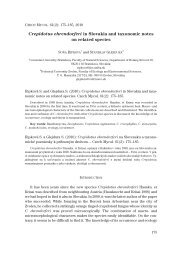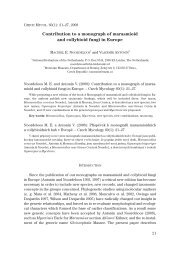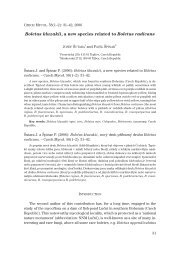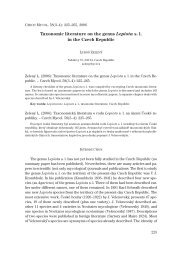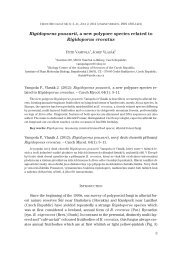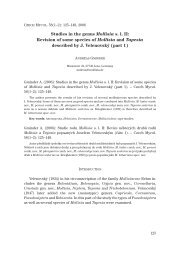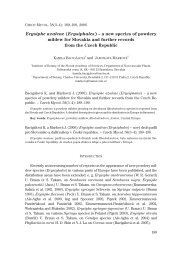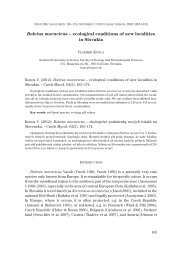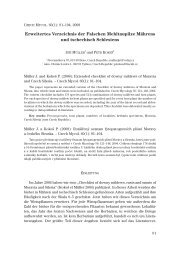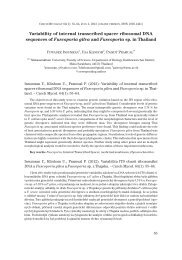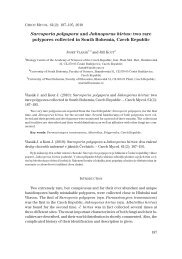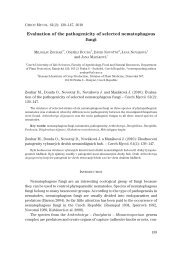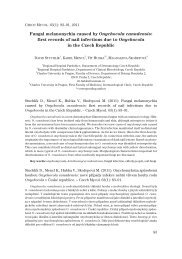You also want an ePaper? Increase the reach of your titles
YUMPU automatically turns print PDFs into web optimized ePapers that Google loves.
<strong>CZECH</strong> MYCOL. 60(2): 221–230, 2008<strong>Flammulina</strong> <strong>ononidis</strong> – a new species for SlovakiaSOŇA RIPKOVÁ 1 ,SLAVOMÍR ADAMČÍK 2 and VIKTOR KUČERA 21 Comenius University in Bratislava, Faculty of Natural Sciences, Department of Botany, Révová 39,SK-811 02 Bratislava, Slovakiaripkova@fns.uniba.sk2 Institute of Botany SAS, Dúbravská cesta 14, SK-845 23 Bratislava, Slovakiaslavomir.adamcik@savba.sk, viktor.kucera@savba.skRipková S., Adamčík S. and Kučera V. (2008): <strong>Flammulina</strong> <strong>ononidis</strong> – a new speciesfor Slovakia. – Czech Mycol. 60(2): 221–230.Although described in 1977 from Germany, <strong>Flammulina</strong> <strong>ononidis</strong> Arnolds was found in Slovakiain 2002 for the first time. Macro– and micromorphological characters of the Slovak collections are describedand illustrated. The delimitation of F. <strong>ononidis</strong> is discussed and the knowledge of its distribution,ecology, biology and threat is summarised.Key words: fungi, Basidiomycota, Xerulaceae, distribution, ecology, biology.Ripková S., Adamčík S. a Kučera V. (2008): <strong>Flammulina</strong> <strong>ononidis</strong> – nový druh preSlovensko. – Czech Mycol. 60(2): 221–230.Hoci bol druh <strong>Flammulina</strong> <strong>ononidis</strong> Arnolds opísaný z Nemecka v roku 1977, na Slovensku smeho prvýkrát našli až v roku 2002. V práci uvádzame opis a vyobrazenie makro– a mikromorfologickýchznakov našich slovenských zberov. Hodnotíme ohraničenie F. <strong>ononidis</strong> a sumarizujeme poznatkyo jeho rozšírení, ekológii, biológii a ohrozenosti.INTRODUCTIONThere are many fungal names with epithets referring to a specific host-fungusinteraction and <strong>Flammulina</strong> <strong>ononidis</strong> is one of them. As a new species,<strong>Flammulina</strong> <strong>ononidis</strong> Arnolds was described in 1977 based on material fromGermany and growing on Ononis spinosa (Arnolds 1977). Although O. spinosa iswidespread in Slovakia, with the exception of the Vihorlat Mts., VýchodnéBeskydy Mts. and Bukovské vrchy Mts. (Chrtková and Jasičová 1988), we confirmedthe occurrence of F. <strong>ononidis</strong> in the country only in the year 2002.The aim of the paper is to describe the first collections of F. <strong>ononidis</strong> forSlovakia, to compare the characters with published data and to summarise thecurrent knowledge of its distribution, ecology, biology and threat.221
RIPKOVÁ S., ADAMČÍK S. AND KUČERA V.: FLAMMULINA ONONIDIS – A NEW SPECIES FOR SLOVAKIAFig. 1. <strong>Flammulina</strong> <strong>ononidis</strong>: basidiocarps (SAV F-1319). Photo by M. Vašutová.Fig. 2. <strong>Flammulina</strong> <strong>ononidis</strong>: basidiocarp (SAV F-1319). Photo by M. Vašutová.223
<strong>CZECH</strong> MYCOL. 60(2): 221–230, 2008Fig. 3. <strong>Flammulina</strong> <strong>ononidis</strong>: a – caulocystidia, b – hyphal terminations on stipe surface, c – spores(SAV F-1319). Scale bars = 10 μm.B a s i d i a 4-spored, narrowly clavate, (25.5–)28–33(–35.5) × 6.5–7 μm, av. 30.7×6.8μm.Spores (7.3–)8.1–10.1(–11.2) × (3.5–)4.1–5(–6) μm, av. 9.1 × 4.5 μm, Q =(1.62–)1.84–2.19(–2.43), av. Q = 2.01, broadly ellipsoid to indistinctly amygdaliform,smooth, hyaline (Fig. 3). P l e u r o c y s t i d i a (33.5–)36–54(–78) × (8–)10.5–16(–19.5)μm, av. 45 × 13.3 μm, lageniform, fusiform-pedunculate, ellipsoid-pedunculate,broadly clavate, thick-walled (c. 0.5 μm); more frequent towards the edge oflamellae (Fig. 4). C h e i l o c y s t i d i a similar to pleurocystidia, abundant.Pileipellis composed of ixohyphidia and pileocystidia. Te r m i n a l c e l l s o fixohyphidia c. 27–65 × 3.5–7.5 μm, mostly of three types: 1) coralloid, 2)branched with one central stem and lateral branches (usually not with more than5 branches), 3) unbranched; all of them usually with constricted or attenuated tips(1–2 μm wide at the tips), thin-walled (Fig. 5). P i l e o c y s t i d i a c. 68–105 × 7.5–12μm, narrowly lageniform, often pedunculate-constricted and sinuose at base,thick-walled (0.5–1 μm) (Fig. 6). S u r f a c e o f s t i p e made up of scarce224
RIPKOVÁ S., ADAMČÍK S. AND KUČERA V.: FLAMMULINA ONONIDIS – A NEW SPECIES FOR SLOVAKIAFig. 4. <strong>Flammulina</strong> <strong>ononidis</strong>: pleurocystidia (SAV F-1318). Scale bar = 10 μm.caulocystidia and cylindrical thin-walled hyphae (Fig. 3). C a u l o c y s t i d i a similarto pileocystidia but wider (c. 12–15 μm). Hyphae thin-walled, moniliform andslightly constricted towards the tips (sometimes also appendiculate), with shortterminal cells (c. 30–50 × 4.5–7 μm); in upper part of stipe thin-walled and hyaline,in basal part with brownish pigment and thick-walled (Fig. 3).P u b l i s h e d f i g u r e s a n d / o r d e s c r i p t i o n s . Anonymus 2 (on-line),Arnolds (1977), Bas (1995), Cetto (1994), Hagara et al. (2005), Kotlaba (1995), Kříž(on-line), Petersen et al. (on-line).N o t e s o n b i o l o g y a n d d e l i m i t a t i o n . There is also another <strong>Flammulina</strong>taxon with its epithet referring to a specific host, namely <strong>Flammulina</strong>velutipes var. lupinicola Redhead et R.H. Petersen. In comparison with the typicalvariety, it can be recognised by larger spores (Tab. 1) and habitat on Lupinusarboreus Sims in coastal dunes in California (Redhead and Petersen 1999). Thesimilar spore size (Tab. 1) and the growth on a leguminous host (Fabaceae) in225
<strong>CZECH</strong> MYCOL. 60(2): 221–230, 2008Fig. 5. <strong>Flammulina</strong> <strong>ononidis</strong>: terminal cells of ixohyphidia (SAV F-1319). Scale bar = 10 μm.both taxa, F. velutipes var. lupinicola and F. <strong>ononidis</strong>, involved discussions abouttheir relationship (Redhead and Petersen 1999). Pairing experiments (Petersen etal. 1999) revealed that F. <strong>ononidis</strong> is compatible with all infraspecific taxa withinF. velutipes, namely with F. velutipes var. lupinicola, F. velutipes var. velutipes(Curtis) Singer and F. velutipes var. lactea (Quél.) Bas. Such sexual compatibilitysuggests a close genetic relationship between these taxa. However, based on ribosomalITS sequences (Hughes et al. 1999), F. velutipes together with its varietiesformed an individual clade, and F. <strong>ononidis</strong> was clustered with F. elastica (Lasch)Redhead et R.H. Petersen. Using two restriction enzymes (Hae III and Bst F51),isolates of F. <strong>ononidis</strong> showed a unique restriction fragment pattern (3–1) withinthe genus <strong>Flammulina</strong> (the pattern is characterised by an additional Hae III sitenear the end of the ITS2 region, creating fragments of c. 55 bp, 100 bp, 220 bp and440 bp; and no restriction site for Bst F51) (Methven et al. 2000). For both matingand molecular analyses, only limited material of F. <strong>ononidis</strong> was available (singleculture from CBS) and Petersen et al. (on-line) therefore hopes to delineate the226
RIPKOVÁ S., ADAMČÍK S. AND KUČERA V.: FLAMMULINA ONONIDIS – A NEW SPECIES FOR SLOVAKIAFig. 6. <strong>Flammulina</strong> <strong>ononidis</strong>: pileocystidia (SAV F-1319). Scale bar = 10 μm.position of F. <strong>ononidis</strong> better in a phylogenetic reconstruction using more collectionsas well as cultures from them.The latest described new <strong>Flammulina</strong> species, F. cephalariae Pérez-Butrón etFernández-Vic., also has its epithet referring to the host Cephalaria leucantha (L.)Roem. et Schult. Its distribution seems to be limited to Losa Valley in the provinceof Burgos (Northern Spain) (Pérez-Butrón and Fernández-Vicente 2007). In comparisonwith F. <strong>ononidis</strong>, F. cephalariae has distinctly larger spores (Tab. 1).Considering that the yellow-brownish slimy pileus and the rooting velvetystipe are typical characters of most <strong>Flammulina</strong> taxa, the habitat (namely associationwith Ononis spinosa) seems to be the only useful character for identificationof F. <strong>ononidis</strong> in the field. Despite this fact, we recommend to check the identificationalso microscopically (especially if the host is unknown). However, F.<strong>ononidis</strong> is also microscopically similar to other <strong>Flammulina</strong> taxa. It hasa pileipellis structure similar to that of F. velutipes and F. elastica, and spore measurementsare necessary to distinguish these taxa. F. <strong>ononidis</strong> has spores on aver-227
<strong>CZECH</strong> MYCOL. 60(2): 221–230, 2008age wider than 4 μm and with a length-width ratio of up to 2.2. F. velutipes and F.elastica have spores on average mostly not wider than 3.5 μm (Tab. 1) and/or witha length-width ratio of at least 2.2 (according to our unpublished observations).The delimitation of F. <strong>ononidis</strong> based on spore dimensions is well discussed byKlán (1978) and Bas (1983). Our measurements of spores of F. <strong>ononidis</strong> fit well tothose published by Arnolds (1977) and Bas (1983) (Tab. 1).For detailed nomenclatural comments, see Arnolds (1977).Tab. 1. Comparison of spore size of some <strong>Flammulina</strong> taxa.Source of measurements of some spore length spore width Q av. Q<strong>Flammulina</strong> taxaF. <strong>ononidis</strong> Arnolds (1977) (7.5) 8.5–13 (14) (4) 4.5–6 – –F. <strong>ononidis</strong> Bas (1983) (7.5) 8.5–12.5 (14) (4) 4.5–5.5 (6) (1.6) 1.7–2.45 1.9–2.3SAV-F 1318 (7.9) 8.5–10 (11) (4.1) 4.3–4.9 (5.1) (1.78) 1.85–2.17 (2.37) 2.01F. <strong>ononidis</strong> SAV-F 1319 (7.3) 7.5–8.7 (10.4) (3.5) 3.9–4.5 (5.1) (1.62) 1.77–2.07 (2.26) 1.92our observationsM 0065416 (8.6) 9.4–10.6 (11.2) (4.1) 4.3–5.2 (6) (1.76) 1.94–2.28 (2.43) 2.11F. velutipes var. lupinicola7–14.8 3.7–6.6av. 4.5–5.4 – –Redhead and Petersen (1999)F. cephalariae Pérez-Butrón and (9.2) 12–16.8 (17) (5) 5.6–7.6 (8) 2 –Fernández-Vicente (2007)F. velutipes (Petersen et al. on-line) 6–9.5 3–4 – 2–2.3F. elastica (Petersen et al. on-line) 8–11.5 3–4 – 2.5–3Ecology. <strong>Flammulina</strong> <strong>ononidis</strong> is a saprophyte inhabiting roots and stembases of Ononis spinosa from August to March. It usually fructifies solitarily, lessoften in small to large groups. The species seems to prefer grasslands on calcareoussoils in stands of the plant communities Bromion erecti Koch 1926 andCirsio-Brachypodion pinnati Hadač et Klika 1944; it has also been mentionedfrom calcareous dunes and river dikes (Antonín 2006, Bas 1995, Hagara et al. 2005,Klán 1978, Kotlaba 1995).We have found F. <strong>ononidis</strong> on an abandoned pasture on sandy soil among herbaceousplants. Its basidiocarps were produced on roots of Ononis spinosa in October(see Material studied).We consider the knowledge of the ecology of F. <strong>ononidis</strong> insufficient, whichcorresponds with its rarity and little number of collections. We would thereforenot be surprised if the spectrum of habitats as well as host plants were morewider, as indicated by Urbonas et al. (1986) who mentioned their collection of F.<strong>ononidis</strong> from another leguminous host, namely from Trifolium pratense L.Distribution. <strong>Flammulina</strong> <strong>ononidis</strong> is hitherto known from Austria (Krisai-Greilhuber 1999), Croatia (Tkalčec et al. 2005), the Czech Republic (Antonín 2006), Belgium(Walleyn and Vandeven 2006), Denmark (Petersen and Vesterholt 2003), France228
RIPKOVÁ S., ADAMČÍK S. AND KUČERA V.: FLAMMULINA ONONIDIS – A NEW SPECIES FOR SLOVAKIA(Anonymus 1, 2 on-line), Germany (Arnolds 1977, Krieglsteiner 1978), Hungary(Babos 1968, Cetto 1994, the collections reported here), Estonia (Urbonas et al.1986), Italy (Petersen et al. on-line), Russia (Petersen et al. on-line), Slovakia (ourcollections reported here) and Turkey (Peks˛en and Karaca 2003).Threat.<strong>Flammulina</strong> <strong>ononidis</strong> is classified as endangered in Austria (Krisai-Greilhuber 1999), Croatia (Tkalčec et al. 2005), the Czech Republic (Holec andBeran 2006) and Germany (Benkert et al. 1996). It is argued that the species isthreatened by agricultural measures, e.g. fertilisation and habitat transformation(Antonín 2006). Steps in preserving F. <strong>ononidis</strong> should, therefore, involve thepreservation of suitable habitats and continuation of the traditional managementactivities, e.g. cultivation without pesticides and herbicides, hand-mowing and extensivegrazing (Biber 1986, Kotlaba 1995).Material studiedS l o v a k i a , Cerová vrchovina Mts., 2 km SWW of the village of Chrámec (near the town of RimavskáSobota), alt. 250 m, on abandoned pasture, on sandy soil, among herbaceous plants, on roots of Ononisspinosa, 27 Oct 2002, leg. K. Skokanová (SAV F-1319). Ibid., 27 Oct 2004, leg. S. Adamčík (SAV F-1318).H u n g a r y, Pilis Mts., prope Budakalász, in pascuo, 1 Nov 1966, leg. M. Babos, G. Bohus, E. Véssey(M 0065416 as <strong>Flammulina</strong> velutipes var. pratensis).ACKNOWLEDGEMENTSAnna Ronikier (Institute of Botany PAS, Krakow, Poland) is acknowledged for reading and commentingon the manuscript. Thanks also go to Natália Yehorová (Institute of Botany SAS, Bratislava,Slovakia) for her advisory note on the habitat of our collections. The Slovak Grant Agency VEGA(grants no. 2/7071/7 and 2/5087/25) supported this study.REFERENCESANONYMUS 1 (on-line): La modernisation des zones naturelles d’intérêt ecologique, faunistique etfloristique en région Nord Pas-de-Calais. –http://www.nord-pas-de-calais.ecologie.gouv.fr/IMG/pdf/informations_generales-2.pdf.[accessed 30 Apr 2008].ANONYMUS 2 (on-line): <strong>Flammulina</strong> <strong>ononidis</strong> Arnolds. –http://www.pharmanatur.com/Mycologie/<strong>Flammulina</strong>%20<strong>ononidis</strong>.htm. [accessed 30 Apr 2008].ANTONÍN V. (2006): <strong>Flammulina</strong> <strong>ononidis</strong> Arnolds. – In: Holec J. and Beran M. (eds.), Červený seznamhub (makromycetů) České republiky, Příroda, Praha, 24: 116.ARNOLDS E. (1977): Einige Pilze eines Halbtrockenrasen bei Detmold (Westfalen). – Westfäl. Pilzbriefe11: 29–39.BABOS M. (1968): Adatok Magyarország ritka kalaposgombáinak és pöfetegféléinek ismeretéhez III.A budakalászi legelögombái. – Fragm. Bot. 6: 23–40.BAS C. (1983): <strong>Flammulina</strong> in western Europe. – Persoonia 12: 51–66.BAS C. (1995): Genus <strong>Flammulina</strong> P. Karst. – In: Bas C., Kuyper Th. W., Noordeloos M. E. and VellingaE. C. (eds.), Flora agaricina neerlandica, Vol. 3, p. 170–173, Rotterdam.229
<strong>CZECH</strong> MYCOL. 60(2): 221–230, 2008BENKERT D., DÖRFELT H., HARDTKE H. J., HIRSCH G., KREISEL H., KRIEGLSTEINER G. J., LÜDERITZ M.,RUNGE A., SCHMIDT H., SCHMITT J. A., WINTERHOFF W., WÖLDECKE K. and ZEHFUSS H. D. (1996):Rote Liste der Großpilze Deutschlands. – In: Ludwig G. and Schnittler M. (eds.), Rote Listengefährdeter Pflanzen Deutschlands, Schriftenreihe für Vegetationskunde 28, p. 377–426, Bonn.BIBER J. (1986): Další krok v ochraně vzácných a ohrožených druhů hub. – Mykol. Listy no. 23: 12–13.CETTO B. (1994): I funghi dal vero, Vol. 6. – 722 p. Trento.CHRTKOVÁ A. and JASIČOVÁ M. (1988): Ononis spinosa L. – In: Bertová L. (ed.), Flóra Slovenska IV/4, p.246–247, Bratislava.HAGARA L., ANTONÍN V. and BAIER J. (2005): Veľký atlas húb. – 432 p. Praha.HOLEC J. and BERAN M., eds. (2006): Červený seznam hub (makromycetů) České republiky. – Příroda,Praha, 24: 1–282.HOLMGREN P. K., HOLMGREN N. H. and BARNETT L. C., eds. (1990): Index Herbariorum 1: The herbaria ofthe world. – 693 p. Bronx, New York.HUGHES K. W., MCGHEE L. L., METHVEN A. S., JOHNSON J. E. and PETERSEN R. H. (1999): Patterns of geographicspeciation in the genus <strong>Flammulina</strong> based on sequences of the ribosomal ITS-5.8S-ITS2area. – Mycologia 91(6): 978–986.KLÁN J. (1978): <strong>Flammulina</strong> <strong>ononidis</strong> Arnolds, ein besonderer Steppen-Samtfussrübling in derTschechoslowakei. – Česká Mykol. 32: 205–214.KORNERUP A. and WANSCHER J. H. (1978): Methuen handbook of colour, 5th ed. – 248 p. London.KOTLABA F., ed. (1995): Červená kniha ohrozených a vzácnych druhov rastlín a živočíchov SR a ČR. Vol.4. Sinice a riasy, huby, lišajníky, machorasty. – 224 p. Bratislava.KRIEGLSTEINER G. J. (1974): Der Hauheckel-Rübling, <strong>Flammulina</strong> <strong>ononidis</strong> Arnolds 1977 auch inSüddeutschland. – Südw. Pilzrundsch. 14: 1–7.KRISAI-GREILHUBER I. (1999): Rote Liste gefährdeter Großpilze Österreichs. – In: Niklfeld H. (ed.), RoteListen gefährdeter Pflanzen Österreichs, Bundesministerium für Umwelt, Jugend und Familie, p.229–266, Graz.KŘÍŽ M. (on-line): Plamienka ihlicová (<strong>Flammulina</strong> <strong>ononidis</strong> Arnolds). –http://www.nahuby.sk/obrazok_detail.php?obrazok_id=30800&poradie=1. [accessed 30 Apr 2008].METHVEN A., HUGHES K. W. and PETERSEN R. H. (2000): <strong>Flammulina</strong> RFLP patterns identify speciesand show biogeographical patterns within species. – Mycologia 92(6): 1064–1070.PÉREZ-BUTRÓN J. L. and FERNÁNDEZ-VICENTE J. (2007): Una nueva especie de <strong>Flammulina</strong> P. Karsten,F. cephalariae (Agaricales) encontrada en España. – Revista Catalana de Micologia 29: 81–91.PEKS˛EN A. and KARACA G. (2003): Macrofungi of Samsun Province. – Turkish J. Bot. 27: 173–184.PETERSEN R. H., HUGHES K. W. and REDHEAD S. A. (on-line): The genus <strong>Flammulina</strong>, a Tennessee tutorial.– http://www.bio.utk.edu/mycology/<strong>Flammulina</strong>/default.html [accessed 28 Jul 2008].PETERSEN R. H., HUGHES K. W., REDHEAD S. A., PSURTSEVA N. and METHVEN A. S. (1999): Mating systemin the Xerulaceae (Agaricales, Basidiomycotina): <strong>Flammulina</strong>. – Mycoscience 40: 411–426.PETERSEN J. H. and VESTERHOLT J. (2003): De danske svampenavne – en kommenteret navneliste. – 76p. Ebeltoft. – http://www.mycokey.com/MycokeyDK/DKkeysPDFs/DeDanskeSvampenavne.pdf[accessed 30 Apr 2008].REDHEAD S. A. and PETERSEN R. H. (1999): New species, varieties and combinations in the genus<strong>Flammulina</strong>. – Mycotaxon 71: 285–294.TKALČEC Z., MEŠIĆ A. and MATOČEC N. (2005): Crveni popis gljiva HR. –http://www.dzzp.hr/publikacije/Crveni%20popis%20gljive.pdf [accessed 30 Apr 2008].URBONAS V., KALAMEES K. and LUKIN V. (1986): Conspectus florum agaricalium fungorum (Agaricaless. l.) Lithuaniae, Latviae et Estoniae (Materies 1778–1984 annorum). – 138 p. Vilnius.WALLEYN R. and VANDEVEN E., eds. (2006): Standaardlijst van Basidiomycota en Myxomycota vanVlaanderen en het Brussels Gewest. – 143 p. Brussel. www.inbo.be/docupload/3062.pdf [accessed30 Apr 2008].230


